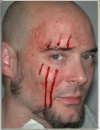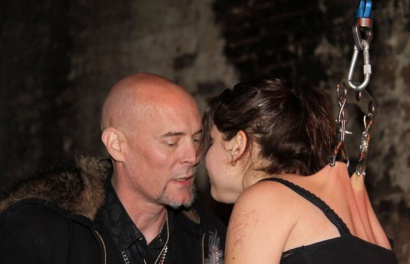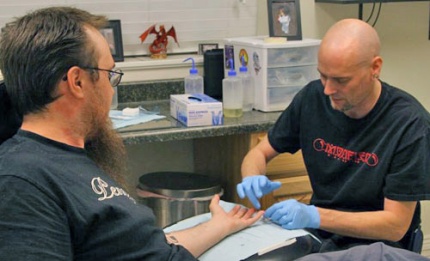Sterilize and Steve Haworth: Difference between pages
(Page conversion via llm-mediawiki-rev -jwm) |
(Page conversion via llm-mediawiki-rev -jwm) |
||
| Line 1: | Line 1: | ||
''' | {| class="toccolours" style="width:200px;float:right;margin:10px;" | ||
|- | |||
! colspan="2"| ''Steve Haworth'' | |||
|- | |||
! colspan="2"| [[File:SteveHaworthScar.jpg|100px|link=]] | |||
|- | |||
! Birth Date | |||
| | |||
|- | |||
! Birth Place | |||
| | |||
|- | |||
! Death Date | |||
| living | |||
|- | |||
! Occupation | |||
| Body modification artist | |||
|- | |||
! Website | |||
| [http://www.stevehaworth.com/ http://www.stevehaworth.com/] | |||
|} | |||
'''Steve Haworth''' is a body modification artist and "human evolution artist" based in Phoenix, Arizona. He is responsible for the invention and popularization of [[Subdermal Implant|subdermal 3D-art implants]], as well as [[Transdermal implants|transdermal implants]], [[Ear pointing|ear pointing]], and electrocautery or "laser" [[Electrosurgery|branding]]. In addition, he invented a very successful variant of the [[Surface bar|surface bar]], and has done pioneering work with [[Magnetic Implant|magnetic implants]], [[Dermal punch|dermal punching]], [[Genital beading|genital beading]], [[Tongue splitting|tongue splitting]] and [[Body suspension|body suspension]]. | |||
Called "the ultimate pioneer and a truly dedicated artist" by [[Bizarre Magazine]], Steve Haworth is often cited as an inspiration by other body modification artists. [[Samppa|Samppa von Cyborg]] calls him the "the most important, most respected body modder out there." [[Shawn Porter]] of the [[ScarWars]] project explains, "I directly credit Steve’s [[Electrosurgery|ESU branding]] as a main influence on the newer generation of scarification artists; his high detail branding (which caused a stir when it was featured in ''In the Flesh'', ''Body Art'' and ''[[Bizarre|Bizarre]]'') showed people that you could do more than just dots, chevrons and geometric shapes." [http://scarwars.net/2009/09/08/esu-steve-haworth/ [1]] According to respected scarification artist [[Ron Garza]], "Steve has always been a pioneer and innovator. He has made a huge contribution to the modification community as a whole and the community wouldn't be the same place it is today without him." [http://scarwars.net/2009/09/08/esu-steve-haworth/#more-471 [2]] The Guinness Book of World Records lists Steve as the "Most Advanced Body Modification Artist", 1999 to present. He has done work on the well-known modified individuals [[Enigma]], [[Katzen]], [[Stalking Cat]] and [[The Lizardman]]. | |||
== Career == | |||
Steve's father was a surgical instrument manufacturer, and he taught Steve the family business. In the late 1980's Steve started his own company in that field, Haworth Med Tech. In the early 1990's began working as a piercer. He opened a successful chain of piercing studios called HTC (Haworth Tech Company). Not content to stick to mainstream piercing, he has continued to innovate throughout his years in the industry. In the mid-Nineties he performed the first transdermal implant, the "Metal Mohawk", on Joe Aylward. [http://www.phoenixnewtimes.com/1997-03-27/news/mane-of-steel/ [3]] At around the same time he began his pioneering work with subdermal implants, starting with implant grade steel and teflon and moving on to carved silicone and finally to the method he still uses now, cast silicone created in molds he produces. He has designed a number of unique and artistic subdermal implants and continues to come out with new designs every year. | |||
In 2005 he sold the HTC chain and retired from active piercing, preferring to concentrate on other body modifications, as well as involvement in many other businesses and interests. He and business partner [[Jesse Jarrell]] create unique silicone body jewelry through their company [[Kaos Softwear]], and Steve creates and produces body modification-themed stainless steel jewelry through his SHS (Steve Haworth Stainless) line. Steve also designs specialized tools for body modification procedures, and teaches seminars on his modification techniques. He founded the [[Body suspension|body suspension]] group [[Life Suspended]], and is part of the production team Horns and Halos, which puts on several fetish-themed events a year. [http://www.azfetishball.com/index1.php [4]] | |||
{| style="text-align: center;" | |||
|- | |||
| [[File:Stevehaworthsuspendingbyrolfbuchholz.jpg|410px|link=]]<br>Steve Haworth performing a suspension | |||
| [[File:Mags-jymmi-and-steve.jpg|430px|link=]]<br>Steve Haworth implanting magnetic jewelry | |||
|} | |||
In the above picture of Steve conducting a suspension, you can see Steve's personally designed suspension setup. It utilizes the [[Flesh Hook|Gilson hooks]] he produces and connects to the rig he designed with shackles, eliminating the weakness of rope at that point. | |||
== | == Film and television appearances == | ||
Director Larry Silverman, who had produced several segments for [[Ripley%27s Believe It or Not|Ripley's Believe It or Not]] about people on whom Steve had done work (such as [[The Lizardman]], [[Enigma]] and [[Stalking Cat]]) decided to do a documentary on Steve himself. The result was the 2007 feature ''[[Flesh & Blood]]''. [http://www.piercingsntattoos.com/?p=141 [5]]. Steve also appears in the 2005 documentary ''[[Modify]]''. [https://www.imdb.com/title/tt0455980/ [6]] In 2009, Steve performed a [[Tongue splitting|tongue split]] on the show ''Extreme Dr. 90210''. [https://www.imdb.com/title/tt1588161/ [7]] | |||
== External links == | |||
* [http://www.stevehaworth.com/ 3D Body Modification & Human Evolution Artist] - Steve Haworth's personal website | |||
* [http://www.fleshandbloodmovie.com/ Flesh & Blood - A Body Modification Documentary] - Flesh & Blood movie website | |||
* [http://bmezine.com/media/all/scar/scarport/sscar/steve-haworth/ Steve's scarification portfolio on BME] | |||
* [https://www.facebook.com/stevehaworthmod Steve's Facebook page] | |||
* [ | |||
Latest revision as of 11:56, 17 September 2023
| Steve Haworth | |
|---|---|

| |
| Birth Date | |
| Birth Place | |
| Death Date | living |
| Occupation | Body modification artist |
| Website | http://www.stevehaworth.com/ |
Steve Haworth is a body modification artist and "human evolution artist" based in Phoenix, Arizona. He is responsible for the invention and popularization of subdermal 3D-art implants, as well as transdermal implants, ear pointing, and electrocautery or "laser" branding. In addition, he invented a very successful variant of the surface bar, and has done pioneering work with magnetic implants, dermal punching, genital beading, tongue splitting and body suspension.
Called "the ultimate pioneer and a truly dedicated artist" by Bizarre Magazine, Steve Haworth is often cited as an inspiration by other body modification artists. Samppa von Cyborg calls him the "the most important, most respected body modder out there." Shawn Porter of the ScarWars project explains, "I directly credit Steve’s ESU branding as a main influence on the newer generation of scarification artists; his high detail branding (which caused a stir when it was featured in In the Flesh, Body Art and Bizarre) showed people that you could do more than just dots, chevrons and geometric shapes." [1] According to respected scarification artist Ron Garza, "Steve has always been a pioneer and innovator. He has made a huge contribution to the modification community as a whole and the community wouldn't be the same place it is today without him." [2] The Guinness Book of World Records lists Steve as the "Most Advanced Body Modification Artist", 1999 to present. He has done work on the well-known modified individuals Enigma, Katzen, Stalking Cat and The Lizardman.
Career
Steve's father was a surgical instrument manufacturer, and he taught Steve the family business. In the late 1980's Steve started his own company in that field, Haworth Med Tech. In the early 1990's began working as a piercer. He opened a successful chain of piercing studios called HTC (Haworth Tech Company). Not content to stick to mainstream piercing, he has continued to innovate throughout his years in the industry. In the mid-Nineties he performed the first transdermal implant, the "Metal Mohawk", on Joe Aylward. [3] At around the same time he began his pioneering work with subdermal implants, starting with implant grade steel and teflon and moving on to carved silicone and finally to the method he still uses now, cast silicone created in molds he produces. He has designed a number of unique and artistic subdermal implants and continues to come out with new designs every year.
In 2005 he sold the HTC chain and retired from active piercing, preferring to concentrate on other body modifications, as well as involvement in many other businesses and interests. He and business partner Jesse Jarrell create unique silicone body jewelry through their company Kaos Softwear, and Steve creates and produces body modification-themed stainless steel jewelry through his SHS (Steve Haworth Stainless) line. Steve also designs specialized tools for body modification procedures, and teaches seminars on his modification techniques. He founded the body suspension group Life Suspended, and is part of the production team Horns and Halos, which puts on several fetish-themed events a year. [4]
 Steve Haworth performing a suspension |
 Steve Haworth implanting magnetic jewelry |
In the above picture of Steve conducting a suspension, you can see Steve's personally designed suspension setup. It utilizes the Gilson hooks he produces and connects to the rig he designed with shackles, eliminating the weakness of rope at that point.
Film and television appearances
Director Larry Silverman, who had produced several segments for Ripley's Believe It or Not about people on whom Steve had done work (such as The Lizardman, Enigma and Stalking Cat) decided to do a documentary on Steve himself. The result was the 2007 feature Flesh & Blood. [5]. Steve also appears in the 2005 documentary Modify. [6] In 2009, Steve performed a tongue split on the show Extreme Dr. 90210. [7]
External links
- 3D Body Modification & Human Evolution Artist - Steve Haworth's personal website
- Flesh & Blood - A Body Modification Documentary - Flesh & Blood movie website
- Steve's scarification portfolio on BME
- Steve's Facebook page